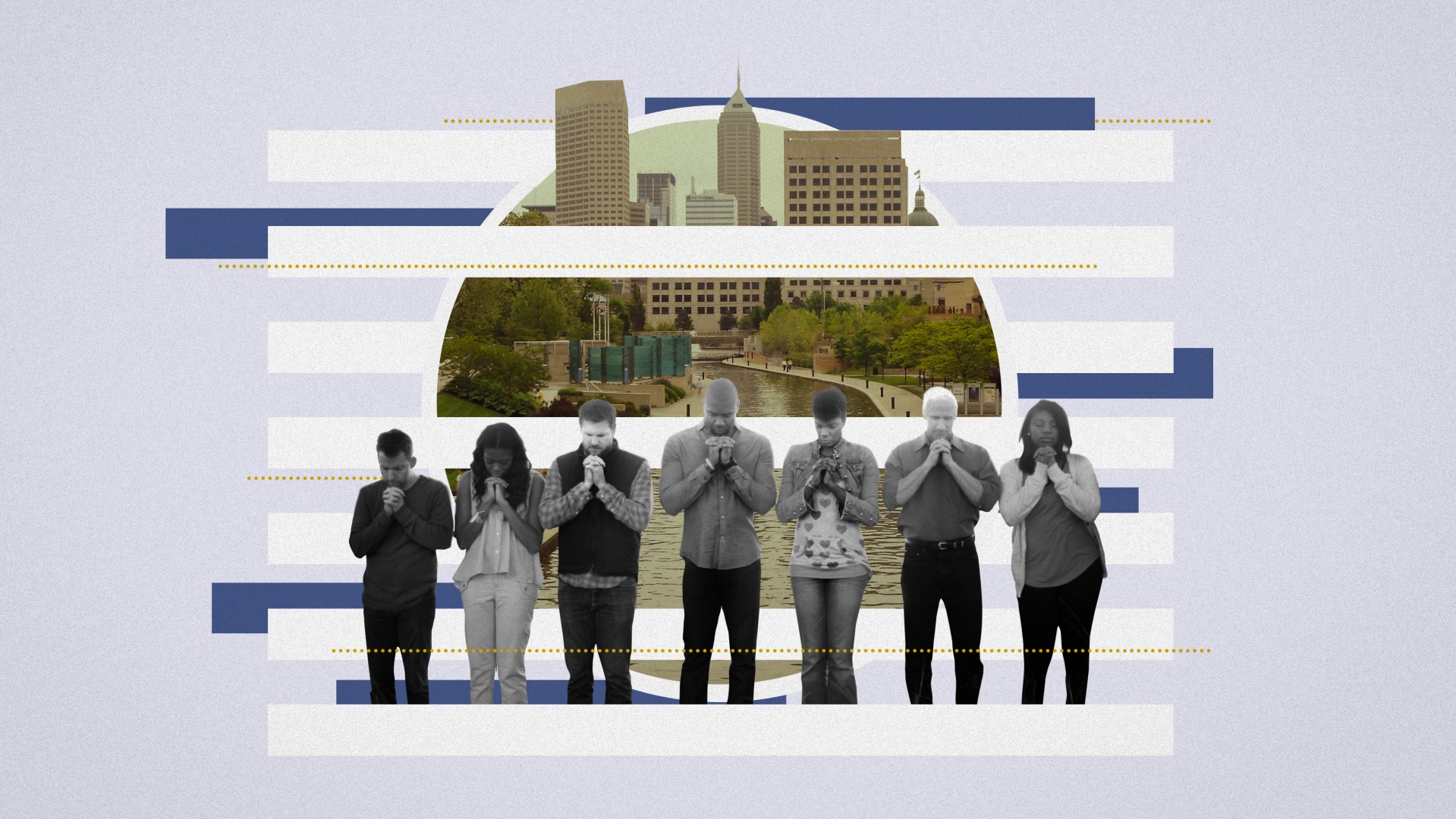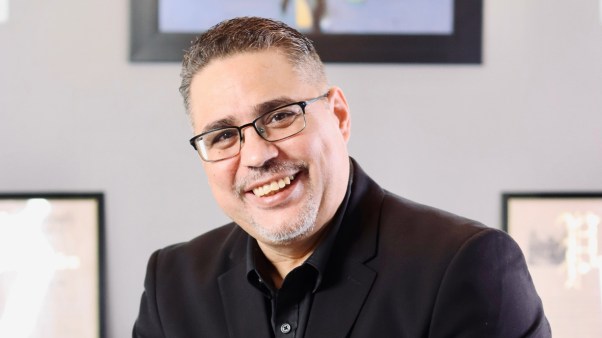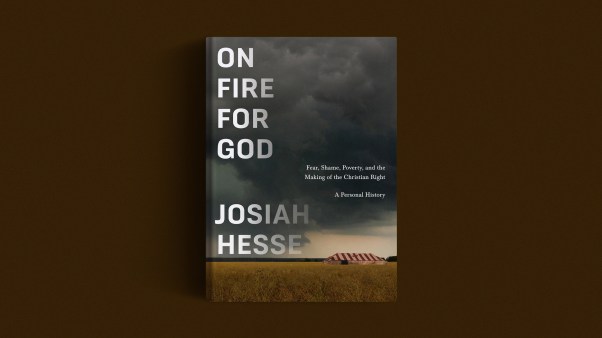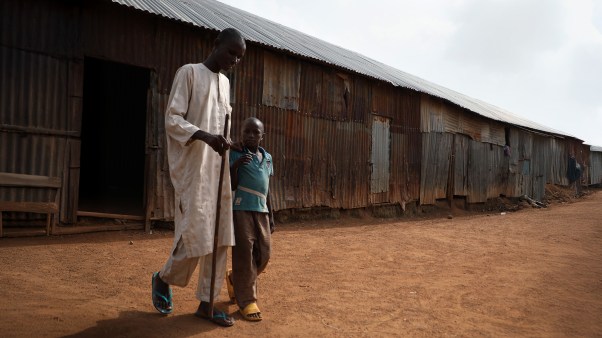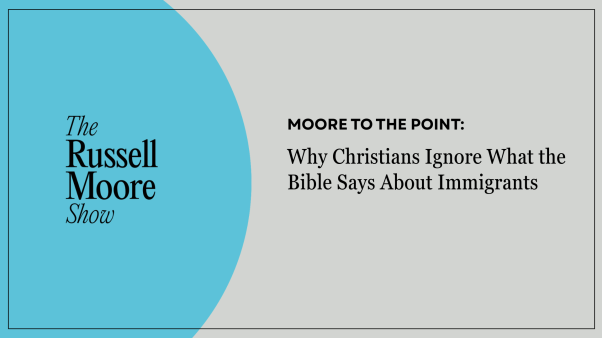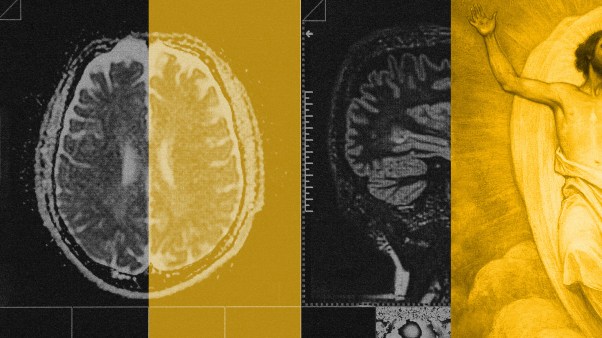On a cool morning in March, I gather at my church with fellow members in Marion, Indiana. We stand in a circle in the parking lot, holding hands, praying not only for our body of believers but also for our town.
This is a church plant of the Evangelical Community Covenant Church, which we call R.E.A.L. Community Covenant Church. We attempt to incarnate our name: We are Relational, Evangelical, Authentic, and Loving. Despite our location in a city with a fraught place in America’s ugly racial history, ours is the only integrated church in the area.
We are a multiethnic, multiclass church, with different experiences of life in America and different journeys to this place. But we have a clear mission: To reconcile residents to Christ and to one other. Colossians 1:20 directs our path. It is Christ—God incarnated, crucified, and resurrected—who will reconcile all people, all things, to himself.
Which is why we are here, holding hands in a stony parking lot. Every one of our prayer walks begin and end here. I’ve been a long time in getting to this place.
I grew up in south Jersey in an affluent suburb, where the schools were so good that my brother, sister, and I had our choice of AP courses and studied Latin for four years. We enjoyed the pleasure of the countryside, too. A few times a year, my parents would pack us up and take us to the Pocono Mountains in Pennsylvania. There, my great-grandfather would lead us through his 40 acres of meadows and woods, remarking on bears and deer that had left their marks and complaining about the loggers who were clearing yet another part of the forest beyond his property.
You could look at my family in that moment and see how we’d earn advanced degrees, establish comfortable lifestyles, and raise our own children in safe neighborhoods.
I was a child of white privilege, though I had no idea. Even after college and graduate school, it was easy for me to believe in the American dream. Hard work and decent living would ensure success. I believed that anyone could achieve the American dream and our laws ensured equality for all. Segregation was over, everyone had the right to vote, and racism was a thing of the past.
But in 1990, I began to teach at Wilberforce University. The school is our nation’s oldest private historical black university, affiliated with the African Methodist Episcopal Church. I quickly learned how many misconceptions I had. A student, for instance, came to me one day before class to let me know she’d missed the previous class because of an appointment at the public assistance office. She whispered this information so low I could barely hear her. Her words destroyed the racist stereotype of the “welfare queen” in 60 seconds.
My students taught me what it was like to hear white passersby hurl racial epithets at them, shop owners follow them around stores, and police officers pat them down because of cross-racial misidentifications. They also taught me hard work isn’t a guarantee of opportunity. And they made me wonder why the depictions of Jesus I had seen all my life were white. Wasn’t our savior a Middle Eastern Jew?
Above all, my students taught me about community. When we talked in class about their educational goals, they would talk about their neighborhoods, families, and friends back home. They were compelled to get an education so they could go back and, as they’d often say, reach back and help someone else up the ladder.
A New Vision of Community
In all my years at church, I had never seen such conviction and solidarity. I’d never seen that commitment to any beloved community. To my shame, I’d never even thought of it. When I was in college, I had two goals: Glorify the Lord and pursue the American dream—both on a fairly individual basis. My objectives included graduating, landing a good job, getting married, and buying a house. Sure, I’d serve in church and cook dinners for people. Maybe I’d even support a missionary. But return to my hometown and help the people I grew up to survive and succeed? Until I taught at Wilberforce, I had never even heard of that. Some of my fellow R.E.A.L. church members have had similar journeys. Like me, they too spent years worshiping in predominately white churches, never questioning why, as Martin Luther King Jr. said, 11 a.m. on Sundays was the most segregated hour of the week. Shara McClanahan, one such member, echoes this experience: “Before R.E.A.L., I primarily did life with people who looked like me, thought like me, talked like me, and believed like me. R.E.A.L. has called me, a white, educated, middle-class female, to join arms with others, to cultivate heaven on Earth through resisting, interrupting, and transforming the systems that create inequity in our world.”
Focused on that mission, our church seeks to develop a beloved community. Just as God the Father, God the Son, and God the Spirit mysteriously work together to convict us, redeem us, and sanctify us from sin, we must work together—carrying each other’s burdens, empowering each other to use our diverse gifts, and reconciling with one another.
As our pastor, Drew Morrell, says, “Don’t roll solo.”
We leave the stony parking lot together and head one block away to Drake’s Outdoor Court, which is located in a resident’s yard. A married couple who once lived there built it when the city of Marion eliminated the two public parks in the neighborhood. Pastor Drew and other men in the church frequent this spot to play games with the kids, get to know them, and invite them to church. We hold our annual church picnic here, too, when we invite police officers and neighbors alike.
We pause beneath the basketball hoop, standing on the blacktop painted with white arcs, circles, and lanes, to pray for this community, the kids who play here, and their families. We invite the Holy Spirit to indwell this place and bless these beloved people.
We continue our prayer walk down the road to St. Martin Community Center. The place bustles with activity because Marion is one of the poorest cities in Indiana. Volunteers serve free lunch, stock the food in the pantry, and sell clothes in the shop for $1. Local businesses donate more than enough food, but the center is often too low on toiletries. We pray with the director for ongoing donations and volunteers, and the strength to carry on. We take with us the idea to do a toiletry drive later, to support the community center’s good work.
We walk several more blocks, and the aroma of barbecue wafts through the air. Someone is always grilling or smoking meat in the neighborhood. We pray at one of many local bars, where some have lost their lives; at the women’s shelter, where two R.E.A.L. women have led Bible studies; and at the Affordable Housing Community Development Corporation, which has helped people in our church.
When we come to the Marion Police Headquarters and Grant County Jail, we pray for our officers to do justly, walk humbly, and love mercy. We pray for their safety. We pray for the prisoners held captive by their sins. We pray for the growing number of women there, due mainly to the opioid crisis here in the Midwest. We pray for those prisoners Pastor Drew holds Bible studies with each week.
A Pastor in His Hometown
As we pray, I recall how Pastor Drew’s first 25 years of life were characterized by deep disillusionment and distraction. He could’ve ended up in this prison, too. His self-destructive trajectory came to a screeching halt, however, when he was shot in the back of the head. It’s almost clichéd to say: He was in the wrong place at the wrong time. A drug deal gone bad. Pastor Drew, the bullet’s unintended victim. It entered from the neck and exited from his jaw. Although he could’ve been involved in something like that—he was involved in similar illegal activities back then—that night, he was just minding his own business. The unbelievable story of his survival made the news, an article he keeps. A reminder of what God saved him from. Oh, how the effectual prayers of righteous men are answered: Drew turned his life over to Christ, enrolled in Indiana Wesleyan University, earned his Bible degree, and now pursues the vital vision God has given him. He seeks to minister in his own hometown, where everyone knows his name.
Jesus himself knows how hard such a mission is. When he returned to Nazareth to teach, the people viewed him with suspicion. He’s just a carpenter! they scoffed. He’s that son of Mary’s. Just a regular Joe. Why should we believe him?
After enduring such disregard, Jesus turned to his disciplines, and said, “A prophet is not without honor except in his own town, among his relatives and in his own home.” And Mark 6:5 then informs us, “Jesus couldn’t do any miracles there, except lay hands on a few sick people and heal them.” The Nazarenes’ lack of faith stunned even Christ, the next verse says.
Perhaps, this is why, at least in my experiences in all my past churches, all of my pastors had come from elsewhere. Frequently, they wouldn’t stay long, either, leaving us after just three, four, or five years. Until Pastor Drew, I have never attended a church in a place where the pastor grew up.
I wonder if there is a connection between proximity and façades, transparency and condemnation. I learned throughout my church life that being honest about one’s struggles means inviting judgment. Better to keep that upper lip stiff, that pain to one’s self. Make everything look good. I remember being a young wife and mother and feeling compelled one Sunday to go forward after the message to ask for prayer. I wanted to reinvigorate my commitment to Christ, which had turned stale. My husband at the time was a deacon, and we’d led the youth group in the past. I was nursery supervisor. One elderly woman in the church who was dear to all of us stunned me afterwards, saying, “I can’t believe you went forward. I always thought you were strong.”
And I was equally at fault, judging others. How deeply sorry I am. How many regrets I have for careless, insensitive things I said.
Pastor Drew doesn’t have the luxury of a façade. When you minister around people who know your every mistake and flaw, you can’t fake it till you make it. It’s a tough assignment, to minister to your hometown.
Yet, there’s something merciful in this, too. Authenticity is possible. People who know Pastor Drew know he knows them, too. He is the one they call to do the funerals when their sons succumb to lethal gunshots. He is the one who welcomes them when they smell his meat grilling and they show up at his back door. Our assistant pastor, Ronnie Farmer, jokes that Drew is the worst person to go to Walmart with because any quick errand can transform into an hour-long trip as he talks to everyone he knows.
Pastor Drew isn’t perfect—and he knows we all know that. But he also says he often wakes at night, weeping for those lost in Marion, asking God to save them.
Prayer is necessary for repair, no doubt about it, but the work is as physical as it is spiritual. Bodies matter. So when he preaches, Pastor Drew insists that as a biracial man, born of a union once illegal in this nation, his very body illustrates both the struggle and the goal: Unite as though you’re one body.
Remembering Our History
We keep walking. Keep praying. We come to our mission’s ground zero: The site of a 1930 lynching. The old courthouse isn’t here anymore. It has been renovated into apartments that the real estate listings call “historic.” Grant County Superior Court now stands across the street.
Like a West African griot, Pastor Drew recounts Marion’s lynching. He tells the story so we may remember, for he has taught us the wisdom in First Nations activist Georges Erasmus’s words: “Where common memory is lacking, where people do not share in the same past, there can be no real community. Where community is to be formed, common memory must be created.”
The story’s hard truths sink in: On August 6, 1930, three African American adolescents, Abe Smith, Tom Shipp, and Jimmy Cameron, were arrested for shooting Claude Deeter during a robbery attempt. Deeter and his fiancée, Mary Ball, both white citizens, sat in his car, parked at the local lovers’ lane. Earlier in the day, Smith had convinced Shipp and Cameron to join him in doing “stick-ups.” Cameron left the scene, however, once he recognized Deeter and decided he didn’t want anything to do with it. Afterwards, Deeter was shot, the police were called, and all three teens were arrested.
Deeter died the following afternoon. All day long, the phones rang with another part of the story sure to rile the white citizens: Mary Ball said the black boys had also raped her.
The lynch mob, led by the Ku Klux Klan and composed of 15,000 white residents, gathered around the maple tree in front of the court house that night. They believed Ball’s story. Besides, Deeter was dead. That much was certain. His bloody shirt had hung from the old jail’s window on Boots Street all day like a flag.
The same townspeople who’d been to church Sunday morning demanded vigilante justice on Thursday night. The sheriff, a KKK member himself, made only a feeble attempt to stop them.
Shipp was first. The mob brutally beat him, then hanged him from the bars on the jail’s window. Smith was next. When he struggled to get the rope off his neck, the crowd beat and stabbed him with tools they took from the iron works nearby. Once dead, he was lynched on the maple tree. Then the men moved Shipp’s body and strung him up there, too. The crowd continued beating the bodies and even stripped clothes off them to take as souvenirs.
An infamous photo of the lynching was snapped by a local photographer named Lawrence Beitler. In the picture, the white people gather together like they would at any public event, like a picnic or parade. One of the women is pregnant. They smile. A man points up at the bodies, hanging above them.
The men brought Cameron to the tree, too. A still-unidentified voice cried out, insisting he had nothing to do with the crime. The voice told the crowd to let him go. No wonder Cameron, the only American to ever survive a lynch mob, later described this voice as “angelic.”
Later, Ball recanted her story. The rape was pure fiction.
We remember.
Moving to Repentance
We let the whole disturbing history spur us to repentance. We pray Daniel 9: “Lord, the great and awesome God, who keeps his covenant of love with those who love him and keep his commandments, we have sinned and done wrong. We have been wicked and have rebelled; we have turned away from your commands and laws” (vv. 4–5).
Individual responsibility is not the point. It’s our country, our city. And the effects of sin are not confined to individuals. Sin harms generations upon generations. So it is for Marion. We follow Daniel’s example, confessing these sins, asking for justice and reconciliation. Prayer is one of the ways to get there.
Another way is to restore broken relationships. In fact, in the name of such justice and reconciliation, 60 Marion residents, led by local activist Torri Williams and Pastor Drew (they attended high school together), have now gathered with representatives from the Equal Justice Initiative (EJI). EJI encourages the healing most of these town members long for as it collects soil from the sites of the lynchings for its Legacy Museum and provides memorials for towns like Marion.
Some citizens have bristled at the idea of a memorial because they don’t want to dig up the past terror. And some of them already are weighed down by the traces of that terror within their DNA.
A growing field of research now concerns epigenetics—what our ancestors pass on to us in addition to eye color and skin tone, proclivities and mannerisms. Apparently, genes remember. These scientists theorize that trauma can actually affect the expression of the genes, though the sequence of the DNA does not change. Thus, just like a family disease, pain can be passed down to subsequent generations.
And so it is in Marion, where some relatives of Shipp and Smith don’t want to reanimate the trauma that has already left its indelible mark on them. And who came blame them?
Epigenetics also tells us some good news, however: The epigenetic effects are apparently reversible. Just recently, Grant County Commissioners gave the green light to Williams and Pastor Drew to have EJI collect the soil, the first step in this process that we pray will lead to deep restoration.
At the end of our prayer walk, when we return to our church, our feet sore, our legs tired, we stretch, drink water, and laugh about our feeble human condition. And it dawns on me as I drain my water bottle that this is the community I’ve longed for all my life, the community my Wilberforce students taught me about three decades ago.
This church, this town—so far away from my suburban Jersey childhood—is a place of healing. Because we can’t flourish on our own, can’t roll solo.
Together, we disparate church members, with our unique journeys to this place, know that in the face of oppression and unending work, our prayers gird the church we are building. Our lives braid a cord that won’t easily be broken.
Julie L. Moore is an associate professor of English and director of the writing center at Taylor University in Indiana. Her most recent book is Full Worm Moon: A Book of Poems.

